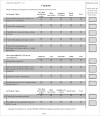HD-PRO-TRIAD™ Validation: A Patient-reported Instrument for the Symptom Triad of Huntington's Disease
- PMID: 24761312
- PMCID: PMC3990832
- DOI: 10.7916/D8PN93NZ
HD-PRO-TRIAD™ Validation: A Patient-reported Instrument for the Symptom Triad of Huntington's Disease
Abstract
Background: Few valid, disease-specific measures of health-related quality of life (HRQOL) capture the spectrum of symptoms associated with Huntington's disease (HD). The HD-PRO-TRIAD™ is a new, HD-specific, patient-reported outcome (PRO) instrument of the HD symptom triad (cognitive decline, emotional/behavioral dyscontrol, and motor dysfunction) designed for clinical research and practice. The objective was to validate the HD-PRO-TRIAD™ through a cross-sectional sample of individuals with HD and caregivers.
Methods: Development of the HD-PRO-TRIAD™ has been described elsewhere. A total of 132 individuals with HD and 40 HD caregivers, comprising 29 dyads, participated in the cross-sectional psychometric validation of this instrument. Participants provided responses to the HD-PRO-TRIAD™ and other HRQOL and disease severity instruments (EuroQOL 5D, Short Form 12, Neuro-QOL Item Banks, PROMIS Global Health, and self-reported Unified Huntington's Disease Rating Scale Total Functional Capacity and Independence Scales). Internal consistency, construct validity, and patient-caregiver proxy consistency were evaluated.
Results: Internal consistency of the three domains and overall HD-PRO-TRIAD™ instrument was supported by Cronbach's alpha values ≥0.94. Construct validity was supported by significant correlations between HD-PRO-TRIAD™ domain scores and other measures of the same domains (e.g., significant positive correlations between HD-PRO-TRIAD™ Anxiety with Neuro-QOL Anxiety), as well as slightly weaker but still strong correlations with other HRQOL instruments (e.g., HD-PRO-TRIAD™ Anxiety and UHDRS Independence; all p<0.01). Consistency between patient self-report and caregiver proxy report was supported by an intra-class correlation coefficient ≥0.92 for all three domains and the overall instrument.
Discussion: These data indicate that HD-PRO-TRIAD™ is a reliable and valid HRQOL instrument that captures the typical triad of HD symptoms.
Keywords: HD-PRO-TRIAD™; Huntington's disease; health-related quality of life; patient-reported outcome; psychometric validation; quality-of-life scale.
Conflict of interest statement
Figures











Similar articles
-
Identifying Motor, Emotional-Behavioral, and Cognitive Deficits that Comprise the Triad of HD Symptoms from Patient, Caregiver, and Provider Perspectives.Tremor Other Hyperkinet Mov (N Y). 2014 Apr 14;4:224. doi: 10.7916/D8JW8BWS. eCollection 2014. Tremor Other Hyperkinet Mov (N Y). 2014. PMID: 24757585 Free PMC article.
-
The quality of life of Spanish patients with Huntington's disease measured with H-QoL-I and EQ-5D.J Mark Access Health Policy. 2016 Oct 13;4. doi: 10.3402/jmahp.v4.27356. eCollection 2016. J Mark Access Health Policy. 2016. PMID: 27826381 Free PMC article.
-
Reliability and Validity of the HD-PRO-TriadTM, a Health-Related Quality of Life Measure Designed to Assess the Symptom Triad of Huntington's Disease.J Huntingtons Dis. 2017;6(3):201-215. doi: 10.3233/JHD-170238. J Huntingtons Dis. 2017. PMID: 28968239 Free PMC article.
-
[Caregiver burden in relatives of persons with schizophrenia: an overview of measure instruments].Encephale. 2003 Mar-Apr;29(2):137-47. Encephale. 2003. PMID: 14567165 Review. French.
-
Quality of Life in Huntington's Disease: Critique and Recommendations for Measures Assessing Patient Health-Related Quality of Life and Caregiver Quality of Life.Mov Disord. 2018 May;33(5):742-749. doi: 10.1002/mds.27317. Epub 2018 Mar 23. Mov Disord. 2018. PMID: 29570848 Review.
Cited by
-
A randomised feasibility study of computerised cognitive training as a therapeutic intervention for people with Huntington's disease (CogTrainHD).Pilot Feasibility Stud. 2020 Jun 19;6:88. doi: 10.1186/s40814-020-00623-z. eCollection 2020. Pilot Feasibility Stud. 2020. PMID: 32577299 Free PMC article.
-
Health state utility estimates for value assessments of novel treatments in Huntington's disease: a systematic literature review.Health Qual Life Outcomes. 2024 Apr 16;22(1):33. doi: 10.1186/s12955-024-02242-1. Health Qual Life Outcomes. 2024. PMID: 38627749 Free PMC article.
-
Assistive Technology for Cognition and Health-related Quality of Life in Huntington's Disease.J Huntingtons Dis. 2016 Oct 1;5(3):261-270. doi: 10.3233/JHD-160210. J Huntingtons Dis. 2016. PMID: 27689618 Free PMC article.
-
Effects and mechanisms of computerized cognitive training in Huntington's disease: protocol for a pilot study.Neurodegener Dis Manag. 2024;14(6):203-216. doi: 10.2217/nmt-2023-0001. Epub 2024 May 11. Neurodegener Dis Manag. 2024. PMID: 39781626 Free PMC article.
-
Using a Clinical Formulation to Understand Psychological Distress in People Affected by Huntington's Disease: A Descriptive, Evidence-Based Model.J Pers Med. 2022 Jul 27;12(8):1222. doi: 10.3390/jpm12081222. J Pers Med. 2022. PMID: 35893316 Free PMC article.
References
-
- Paulson HL, Albin RL. “Huntington's disease: clinical features and routes to therapy.”. In: Lo DC, Hughes RE, editors. Neurobiology of Huntington's disease: Applications to drug discovery Frontiers in Neuroscience. Boca Raton: CRC Press; 2011. (Chapter 1. PM1D 21882418).
-
- Cella DF. Measuring quality of life in palliative care. Semin Oncol. 1995;22:73–81. - PubMed
LinkOut - more resources
Full Text Sources

